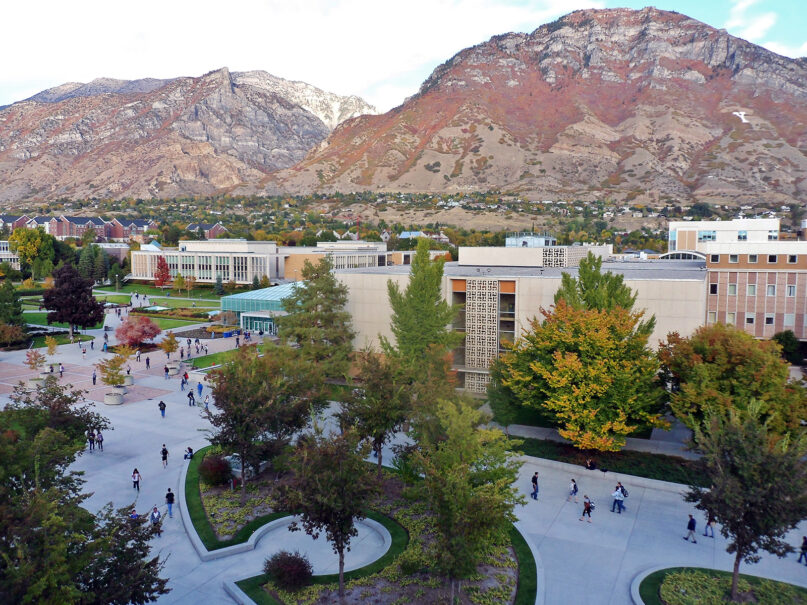(RNS) — This week, the Church of Jesus Christ of Latter-day Saints put into action a new policy, aligning expectations for conduct at all four of its colleges in the United States: Brigham Young University, its flagship school in Provo, Utah, as well as BYU’s satellite campuses in Idaho and Hawaii and Ensign College in Salt Lake City (formerly known as LDS Business College).
In recent years, the BYU campuses have each acquired somewhat different reputations, based on the level of orthodoxy they seemed to manifest. BYU-Idaho has been seen as the strictest of the three, especially in terms of dress (no shorts, capri pants, or flip-flops) and BYU-Hawaii the most relaxed (though some students and former students have disputed that any such thing as a surfer-chill vibe exists at the school). BYU-Provo, the largest, most selective and most academically rigorous, was thought to be somewhere in the middle.
Now, they’re all supposed to adhere to one standard, unified code.
Since the new policy was announced, a good deal of attention has been paid to the fact that dress and grooming standards will be (finally!) standardized at all four schools. In practice, this means that BYU Idaho students can now wear shorts, so there is much rejoicing in Rexburg.
The updated dress codes seem to be taking a cue from the recent revisions to the church’s “For the Strength of Youth” pamphlet, by which I mean they are pretty restrained in terms of specific recommendations about hem lengths, double piercings, tattoos or shoulder coverage. They just give the general advice that “Dressing in a way that would cover the temple garment is a good guideline, whether or not one has been endowed” and leave it at that.
In this, I think the new guidelines represent progress. A legalistic focus on appearance has for too long dominated the church’s advice for young people. In the inaugural 1965 FTSOY pamphlet eight pages were devoted to the question. Most of its advice was aimed at policing the bodies of girls and young women, who were told to avoid such dangerous fashion choices as … pants.

The BYU-Idaho campus in Rexburg, Idaho. Video screen grab
So by comparison, one step forward about BYU’s new guidelines is that they offer the same basic counsel for men and women alike: all are told to “Be modest in fit and style.” If anything, the instructions are a bit stricter for men, who have the added guidance that their hair “should be neatly trimmed” and that they “should be clean shaven.” (Sorry, beard advocates.)
Another step forward is that the overall goal is “to help students grow closer to Jesus Christ,” which seems like the best possible benchmark for a Christian school to shoot for.
But if the updates giveth, they also taketh away.
As Religion News Service explained in a news story earlier this week, when it comes to LGBTQ students, the guidelines cement into de jure law what had previously been de facto practice. “Same-sex romantic behavior” is now forbidden by the honor code at all of the church-owned schools.
What’s more, “romantic behavior” isn’t defined, which leaves students with questions about what might get them in trouble.
That vagueness puts a good deal of power in the hands of the local bishops, who will be responsible for deciding whether students are worthy of the ongoing “ecclesiastical endorsement” that’s necessary to continue attending the school.
The nightmare scenario would be for bishops to probe queer students’ social lives to an unhealthy degree. “Why did you go to the movies with another guy, just the two of you? Did you hold hands? What did you do after the movie?”
I think this scenario is unlikely, but it shouldn’t be an option that’s even on the table. So in that sense, it’s probably a blessing that the church has also instituted a standardized, uniform script for bishops to follow when doing ecclesiastical endorsements for any of the church-owned schools.
The new interview template is similar to that of a temple recommend interview, but not the same. The church says that’s because the goals of the two kinds of interviews are different: “There is a difference in the standard of worthiness to receive saving ordinances in the house of the Lord and being eligible to attend a CES (Church Education System) institution as a student.”
In the BYU interview, there’s an interesting emphasis on “striving.” Some version of the word comes up five times in the template’s 12 questions. The focus seems to be on progress, not perfection. They want students doing their best to develop a testimony of God and Jesus, be honest, work toward “moral cleanliness” (which is not defined), sustain their church leaders and generally live the teachings of the church.
That focus on “striving” seems a promising development, but given some other (mostly negative) changes that have been happening at BYU’s campuses in the past few years, I’m adopting a wait-and-see approach. This is the same university system that recently declined to renew the teaching contracts of some faculty members without saying why. One suspected it was because she had worn a rainbow pin to class and mentioned having gay family members. In 2022, new hires were required to affirm that they supported the church and had a testimony of its doctrine, “including its teachings on marriage, family, and gender.”
So in its drive to standardize the BYU experience across multiple educational institutions, the church is also edging out community members who support LGBTQ rights and same-sex marriage.
Related content:
BYU officially restores honor code ban on ‘same-sex romantic behavior’
Are double piercings and sleeveless tops OK now for Mormon teens?
Correction: An earlier version of this column had reversed the usage of de jure and de facto. RNS appreciates the reader who pointed this out!






